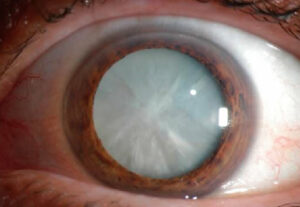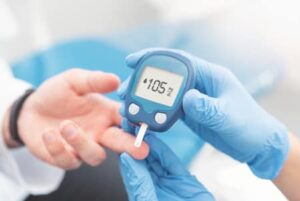If you have been told by your doctor that you have mild cataracts, it is important to understand what this means. Cataracts are a common eye condition that can occur in people of all ages. In most cases, they are caused by the natural aging process. While mild cataracts do not always require treatment, they can still cause problems with vision. In this blog post, we will discuss the symptoms and treatment options for mild cataracts.
What Are Mild Cataracts?

Mild cataracts are a common, age-related condition in which the lenses of your eyes become less transparent. This can cause blurry vision and increased sensitivity to glare. Cataracts usually develop slowly and painlessly, and can eventually lead to blindness if left untreated.
Fortunately, cataracts can be easily treated with surgery. During this procedure, your surgeon will make a small incision in your eye and remove the cloudy lens. They will then replace it with a clear artificial lens. Cataract surgery is safe and effective, and most people experience significant improvement in their vision afterward.
If you think you may have mild cataracts, schedule an appointment with your eye doctor for a comprehensive exam. They will be able to diagnose cataracts and recommend treatment options based on the severity of your condition.
Signs of Mild Cataracts
There are many signs of mild cataracts, most of which are easily detected during a comprehensive eye exam. One common sign is a change in the way you perceive colors. You may also notice that your vision is not as sharp as it used to be, and you may see halos around lights.
Some of the other signs of mild cataracts are:
Blurry or Fuzzy Vision
One of the most common signs of cataracts is blurry vision. This happens because the cataract clouds your natural lens, which makes it difficult for light to pass through.
Glare and Halos
Another common symptom of cataracts is seeing glare and halos around lights. This can make driving at night very difficult, as the headlights will seem much brighter than usual. You may also notice that sunlight seems to be too harsh.
Changes in Color Perception
One of the first signs that you may have a cataract is a change in color perception. Colors may seem faded or less vibrant than before. You may also have difficulty distinguishing between similar colors, such as blue and green.
Glare and poor night vision
This sign of cataracts is especially troublesome because it can make driving very difficult. If you have trouble seeing at night or if bright lights seem to cause glare, it’s important to see an eye doctor right away.
Double vision in one eye
One of the most common symptoms of cataracts is double vision in one eye. This happens because the cataract clouds your natural lens, which makes it difficult for light to pass through. This double vision may go away when you close one eye, but it will return when you open both eyes.
The constant need for new eyeglasses or contact lenses
If you find yourself needing to get new glasses or contacts more often than usual, it could be a sign of cataracts. This is because the cataract changes the shape of your eye, which affects how light passes through.
Reasons for Mild Cataracts

Like any other cataracts, mild cataracts are usually the result of aging. As we age, the proteins in our eyes start to break down and clump together. These clumps cause the lens of the eye to become cloudy, which leads to vision problems.
Some of the other reasons for mild cataracts include:
Diabetes
Diabetes is one the most common causes of cataracts. People with diabetes are more likely to develop cataracts at a younger age and cataracts tend to be more severe. This diabetes also tends to progress more quickly.
Prolonged exposure to ultraviolet (UV) light
Exposure to UV light speeds up the breakdown of proteins in the eyes and can cause cataracts at a younger age. This is why it’s important to wear sunglasses or contact lenses that offer UV protection.
Smoking
Smokers are twice as likely to develop cataracts as nonsmokers, and they tend to develop them at a younger age. Smoking also increases the risk of complications after surgery.
Certain medications
Corticosteroid medications can increase the risk of developing cataracts. These medications are often used to treat conditions like asthma, arthritis, and lupus. If you take corticosteroids, your doctor will closely monitor you for cataracts.
Eye injuries
An injury to the eye, such as blunt trauma, can also cause cataracts. In most cases, the cataract will form in the area of the injury. These eye injuries usually require immediate medical attention.
Exposure to UV light
Exposure to ultraviolet (UV) light from the sun is a major risk factor for developing cataracts. This is why it’s so important to wear sunglasses and hats when you’re outdoors. This new
also helps to explain why people who live in sunny climates are more likely to develop cataracts.
Do Mild Cataracts Affect Your Lives?
Mild cataracts are a common type of vision problem. In fact, by age 80, more than half of all Americans have a cataract or have had cataract surgery.
A cataract is a clouding of the eye’s lens. The lens is the clear part of your eye that helps you focus. It sits just behind your iris — the colored part of your eye — and pupil.
As we age, some changes in the lens are to be expected. But sometimes these changes can cause blurry vision, glare, or trouble seeing at night. When this happens, it’s called a cataract.”
Cataracts usually develop slowly and don’t disturb your vision early on. You might not even notice a cataract at first. But as it grows, it can begin to interfere with your vision. You might have trouble seeing to read or drive, for example, and find yourself needing more light than usual for these activities.
It also impacts the way colors look to you. For instance, a white piece of paper might look yellowish. And bright lights might bother you more than they used to.
If you have a cataract, several things can be done to help restore your vision. In most cases, surgery is the only way to remove a cataract and improve your vision.
Can You Treat Mild Cataracts?

Usually, cataracts cannot be reversed and will require surgery to improve vision. However, in some cases, such as when the cataract is very small, new glasses or a change in your eyeglass prescription may help for a time. If you have diabetes, keeping your blood sugar under control may also help slow the progression of cataracts.
Surgery
Cataract surgery is generally a safe and effective procedure that can improve vision significantly. Newer surgical techniques allow surgeons to remove cataracts through much smaller incisions than in the past, which results in faster healing times.
After surgery, most people experience an immediate improvement in their vision. It may take several weeks for your vision to stabilize as your eye adjusts to its new intraocular lens. During this time, you may experience some glare and light sensitivity. These side effects are usually temporary and will resolve within a few weeks to months.
If you have any questions about cataracts or cataract surgery, be sure to talk to your eye doctor. They can help you determine if cataract surgery is right for you and answer any questions you may have about the procedure.
Medications
Other medications that can help with the symptoms of mild cataracts are:
- Anti-inflammatory drugs: These can help reduce inflammation and pain around the eye.
- Corticosteroids: These can help reduce inflammation and swelling around the eye.
- Antioxidants: These can help protect your vision by reducing oxidative stress, which is a leading cause of cataracts.
If you have any questions about these medications or their side effects, be sure to talk to your doctor or pharmacist. They can help you determine if these medications are right for you and answer any questions you may have about them.
Can Someone Prevent Mild Cataracts?
Preventing mild cataracts may not be possible, but there are some things you can do to help reduce your risk.
Wearing Sunglasses
One of the most common ways to help prevent mild cataracts is by wearing sunglasses. Sunglasses protect your eyes from harmful ultraviolet (UV) rays. These UV rays can damage the proteins in your eye, which may lead to the development of cataracts.
So, if you want to help reduce your risk of developing mild cataracts, be sure to always wear sunglasses when you’re outdoors.
Quit Smoking Cigarettes
Smoking cigarettes is one of the worst things you can do for your health – and this includes your eye health.
Cigarette smoke contains harmful toxins that can damage the proteins in your eye, leading to the formation of cataracts.
So, if you smoke cigarettes, the best thing you can do for your eye health is to quit.
Eat a Healthy Diet
Eating a healthy diet is not only good for your overall health, but it’s also good for your eye health.
Certain nutrients, like vitamin C and omega-three fatty acids, have been shown to help reduce the risk of developing cataracts.
So, if you want to help keep your eyes healthy and reduce your risk of developing mild cataracts, be sure to eat plenty of nutrient-rich foods in your diet.
Get Regular Eye Exams
Finally, one of the best things you can do for your eye health is to get regular eye exams. These exams allow your eye doctor to check for any signs of cataracts or other eye problems.
If you have a family history of cataracts, be sure to tell your eye doctor so they can keep a close watch for any changes in your eyes.
By following these tips, you can help reduce your risk of developing mild cataracts. If you have any concerns about your eye health, be sure to talk to your eye doctor. They can help you determine the best course of action for keeping your eyes healthy and free from disease.
Conclusion
Mild cataracts are very treatable. If you have any concerns, be sure to talk to your doctor. They can help you determine if you have a cataract and what the best treatment options are for you. Don’t let mild cataracts keep you from enjoying your life!
If you have mild cataracts, there is no need to worry. These cataracts are very treatable and there are many options available to you. Be sure to talk to your doctor so they can help you determine the best course of treatment. Don’t let mild cataracts stop you from enjoying your life!
Cataract surgery is a safe and painless procedure. At EyeMantra we have a team of experienced eye surgeons, who will be happy to answer your questions on cataract surgery, cataract surgery cost, and cataract lens cost for different cataract surgery types- Phacoemulsification, MICS & Femto Laser Cataract. Call us at +91-9711116605 or email at [email protected] for inquiries.


